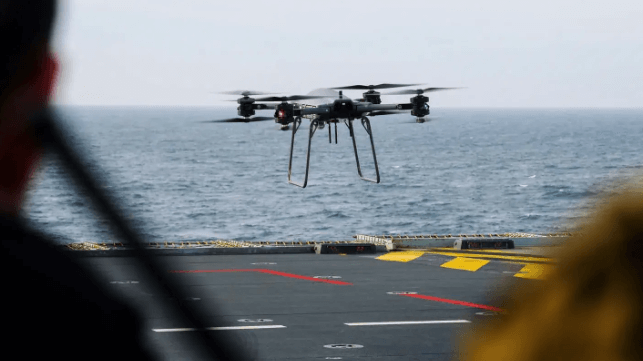Royal Navy Carrier Puts Cargo Drones Into Operational Use

For the first time, a small squadron of nine octocopter cargo drones will sail with HMS Prince of Wales and her carrier strike group, according to the Royal Navy. It is a money-saving technological milestone, and marks the first use of unmanned aircraft for replenishment and stores transfer between ships in the task force.
The drone squadron will operate alongside the F35B stealth jets and naval helicopters on HMS Prince of Wales, handling deliveries of food, personal packages, and engineering parts weighing up to 68 kilos (150 pounds). The Royal Navy says that this will take helicopter flight hours off of cargo missions and allow the helicopter aircrews to focus on their primary protective missions.
"95 percent of stores transferred weigh less than 50kg," said Lieutenant Matt Parfitt, drone flight commander with 700X Naval Air Squadron. "In the past we'd have used a helicopter if a part was urgently needed on another ship. This time we're going to use a remotely-piloted, uncrewed system instead."
The Malloy T-150 drones used on the deployment have eight two-foot rotor blades and can fly at speeds up to 50 knots, with an endurance of 20-40 minutes. Each drone requires a two-person team - a remote pilot and a command unit monitor - and the unmanned systems can be flown manually or programmed to follow designated waypoints.
The drone systems were acquired in August, leaving the Navy with limited time to develop operational procedures, training, and integration with crewed aircraft operations. Lieutenant Parfitt noted the challenges of adapting the primarily land-based systems for maritime use.
"These systems have only really been used over land before, so we're also having to understand how we can operate and maintain them in the maritime environment," he said.
The 700X Naval Air Squadron has assembled a team of 12 sailors to operate the nine drones, initially from three ships in the group. The squadron includes personnel from various naval branches who have been retrained as drone operators.
Among them is Able Rate Michael Page, who transitioned from aircraft handling to become a remote pilot qualified on both the Malloy and smaller fixed-wing Puma drones. "You've got a lot more responsibility in this role and they don't just need to look at your rank, instead they look at your level of skill," Page said.
The drones were developed through a Ministry of Defence research project aimed at accelerating the adoption of new technology. The Royal Navy's experimental 700X Naval Air Squadron trialed a far larger Malloy T-600 rotary wing drone at RNAS Culdrose in 2022, alongside a Windracers Autonomous Systems Ultra fixed-wing drone.
The Ultra is a twin-engine, aluminum-bodied unmanned plane that can drop a payload onto a carrier-sized landing pad at a range of more than 500 nautical miles - but it can't do ship-to-ship vertical replenishment runs, the day-to-day logistics workload of a carrier strike group at sea.
